A six-game winless run in their final six La Liga matches condemned Getafe CF to an eighth-place league finish – missing out on a Europa League position by just two points. José Bordalás and Getafe will be disappointed that they missed out, especially as they were flirting with European qualification all season and put in some excellent performances early on in the prolonged 2019/20 campaign. Getafe set out to frustrate their opposition. They defend with solidity and discipline, which is exemplified by the fact they only conceded 37 goals in the league this season. This defending begins right up the pitch with the attackers, and striker Jaime Mata is an integral cog in both Getafe’s defensive and attacking machines. He is a hard-working forward, and this scout report will provide a tactical analysis of just how big a part Jaime Mata plays in the Getafe team.
Overview
Jaime Mata joined Getafe in July of 2018 on a free transfer as a 29-year-old. In the 2017/18 season, he scored 35 goals in 43 games for Real Valladolid and led them back to La Liga. The following season, he scored 16 and assisted 6 in what was his first-ever season in La Liga, firing Getafe into the Europa League group stages. Now, at 31, Mata is showing no signs of slowing down. The Spaniard works tirelessly in the rigid system employed by Bordalás and still contributes effectively in front of goal. To further understand his role in the team, we will address his heatmap from the season.
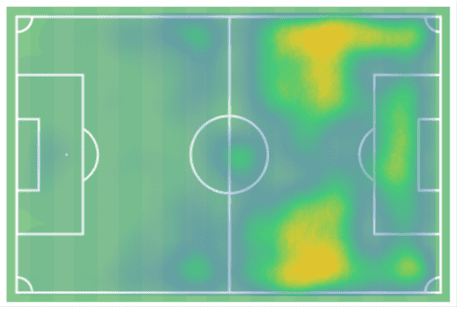
The wide areas are deeply coloured, which initially seems strange for a central-striker. However, this is explained by both the pressing style and attacking methods of Getafe. While the favoured formation of José Bordalás is 4-4-2, Getafe press in a system which more resembles a 4-3-3. This consists of a central-midfielder pushing up in-between the two strikers and the wide midfielders tucking in centrally, meaning that it is the two strikers who press the wide areas. Mata is also frequently positioned on the flanks in attack, as Getafe like to hit balls over the top into the channels for their tenacious strikers to chase. We finally can see the penalty area coloured, which gives evidence for the poaching tendencies of Mata.
These three features of his game will be explained further throughout this report, as we explain the role of Mata in the Getafe team. It is obvious that the Spaniard’s play style is a product of the system his manager employs, but Mata suits these roles perfectly.
Defending from the front
Anyone who has watched Getafe under Bordalás will be aware of their relentless high-press, with a PPDA average of 6.5. Against teams who like to play out from the back, they will press right up the pitch in an attempt to win back the ball and create a counter-attacking chance. While 4-4-2 is the preferred formation, they are keen to press in the 4-3-3 shape that was mentioned above. This is depicted in the still below.
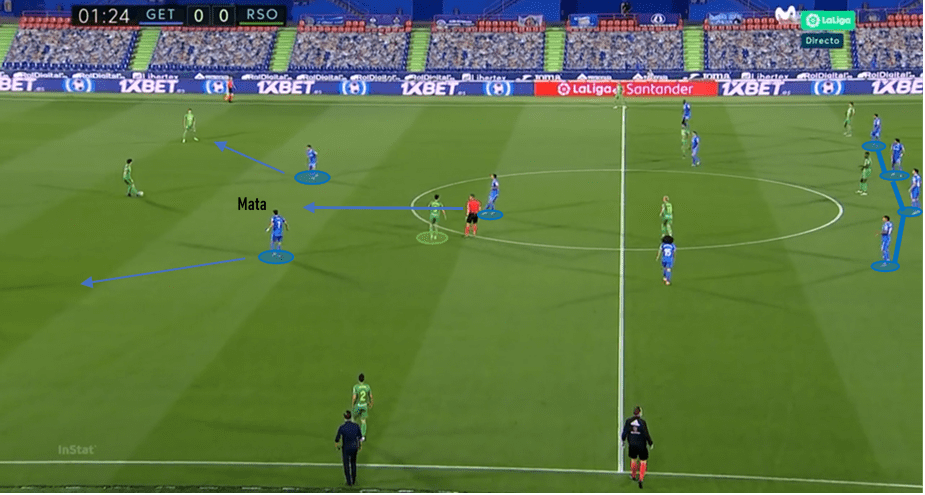
Mata takes a high position ready to press the wide opposition defender, with the other striker ready to push wide. Mata is a hard-worker and covers a lot of ground when pressing. He is rewarded for his pressing efforts with 1.04 final third recoveries per 90, and also 1.84 counter-pressing recoveries per 90. Additionally, 66.7% of Getafe’s recoveries occur in the channels, showing the importance of Mata in their pressing system.
While the system itself can generate such high recovery figures, Mata must be accredited for his tenacity. He doesn’t press in a brainless manner, rather, he closes down the space and waits for his moment to intercept or tackle. Below we can see how Mata’s recovery figures compare to other La Liga players. While they are only average, it is notable that his 35 recoveries have led to eight shots on goal and four goals. Furthermore, 49% of these recoveries have been out wide, and 34% of them have been in the half-spaces, personifying Mata’s wide positioning when pressing high.
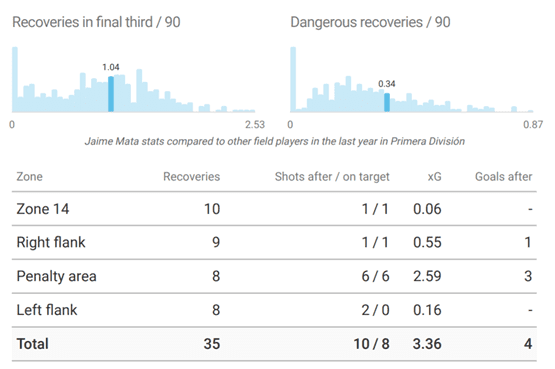
Despite being over 6 foot tall, Mata’s agility cannot be questioned, and while this brings benefits going forward, it is incredibly beneficial for defending in this manner also. We can conclude that Bordalás didn’t only sign Mata for his goalscoring abilities, but also for his willingness to work within a defensive system. His recovery map is shown below, and while the majority of these defensive actions occur out wide, the spread of recoveries attest to the hard-working nature of the Spaniard. Mata was 29-years-old when he finally signed his first La Liga deal with Getafe, and although this was late in his career, it is a testament to the determination that he plays with in every match.
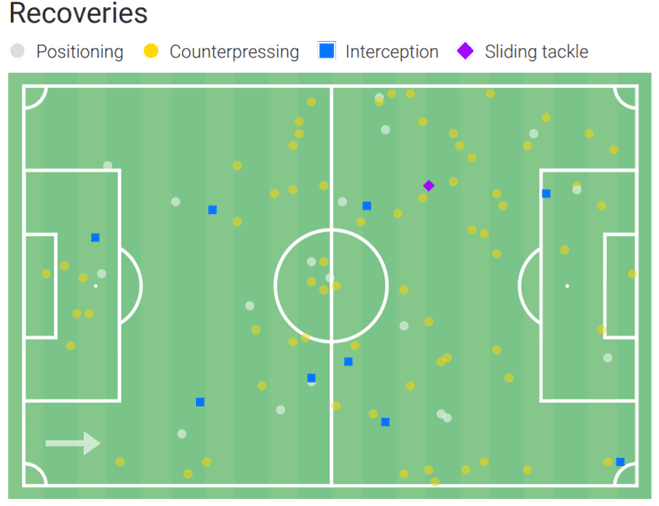
Working the channels
Mata often operates in the wide areas while Getafe attack also. One of their main transitional tactics is a long ball over the top of the opposition defence into the channels, with an average of over 40 long passes attempted per game. This can turn opposition defences onto their heels and create imminent danger. Mata is quick off the mark and also good in the air, meaning any kind of long ball will suit him. In the still below Mata had just received a long pass in behind and went on to put in a cross after outpacing the defenders.
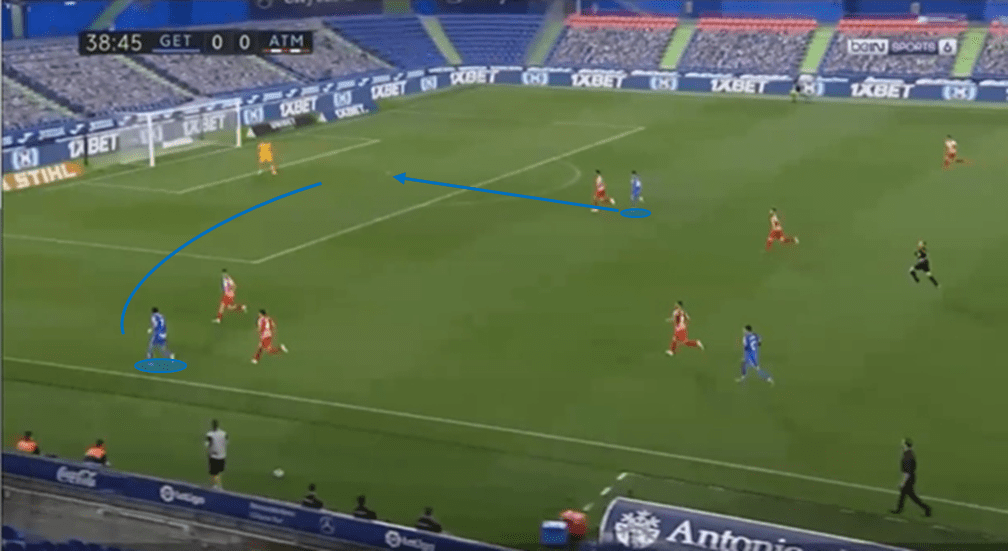
Mata himself engages in 9.69 offensive duels per game, and while he receives the 61st most passes of La Liga attackers per game with 12.85, he receives the 36th most long passes per game, with 2.06. We can further exemplify his frequent exploits in the wide areas by considering his touches in the opposition penalty box. With 3.16 per 90, he takes just the 45th most touches of this manner out of all La Liga attackers. Bearing in mind that Mata is a central striker, these figures seem minuscule. Yet this personifies just how wide Mata (and Getafe) like to attack.
He is not wasted in these areas, however. As mentioned, his pace and aerial ability enable him to win these duels and drive his team forward out wide. Furthermore, he is an adept crosser of the ball and looks to cross early when he reaches the final third. The graph below depicts his crossing stats compared to other La Liga strikers from this season. With 1.87 crosses per 90, just five strikers attempt more than him. He is successful when crossing the ball 34.4% of the time also – a figure which is above average.
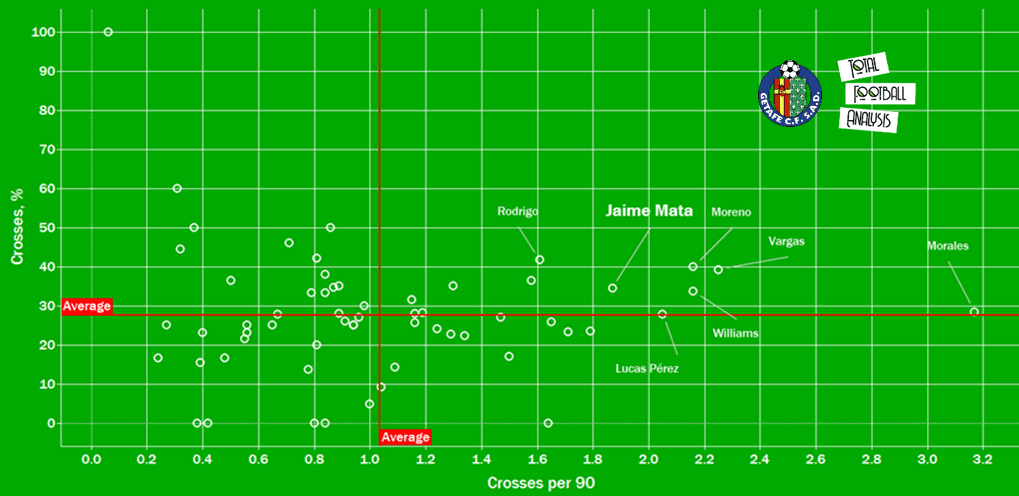
Owing to these figures, we can understand why Mata accrued three assists – the same amount as Antoine Griezmann of Barcelona – and an xA of 0.1 per 90 this season (the average of all La Liga strikers was 0.0863). He is very much a striker who works hard and creates chances for his team, and values this above scoring himself. Below is his ball progression chart and a map of his shot assists. These too show how he begins in the wide areas and looks to drive his team on from here.
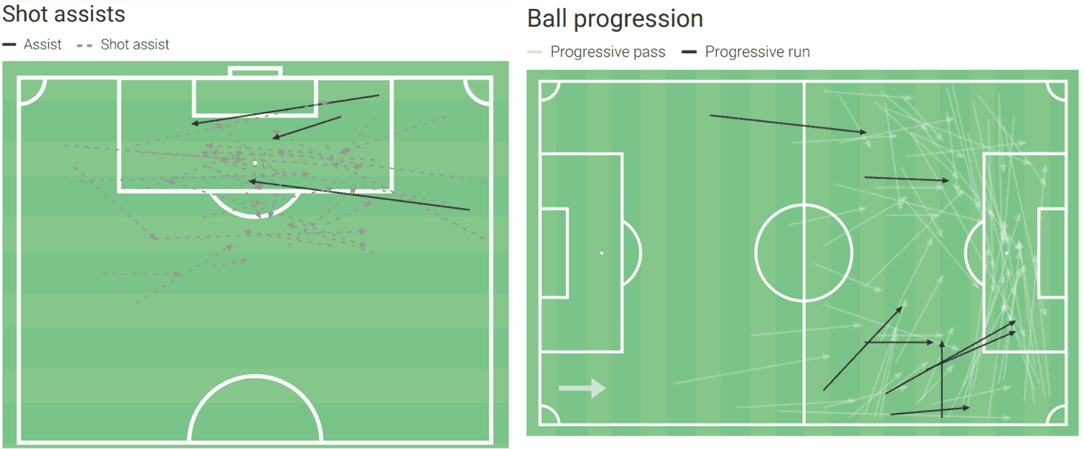
Mata is very much a role player in the system preferred by Bordalás, adapting his game to fit into the scheme of play. However, he is arguably the perfect person to play this role. He doesn’t operate as your orthodox striker would, but his work rate is his hugest asset. He plays with an enjoyment and enthusiasm of a teenager, and clearly remembers his days in the Segunda B division. Yet still, Mata’s primary task is to score goals, and this is something which he succeeds in.
End product
When Getafe do not counter-attack and decide to build-up slower, Mata remains central and aims to get himself into central goalscoring areas where he can poach. He scored 11 league goals this season against an xG of 11.34, which suggests some degree of efficiency in front of goal – something anyone who watches him will be able to agree with. In fact, despite attempting the 21st most shots of La Liga attackers this season (1.56 per 90), he scored the 13th most goals (0.34 per 90).
Mata can score, and also create, all types of goals. In terms of creation, the still below perfectly displays his eye for goal, even if it isn’t him scoring. With the ball out wide, instead of remaining stationary and waiting for the ball, Mata attacked the free space towards the front of the box in order to receive the ball from Damián Suárez. Alive to the opportunity, he was able to leave his marker and freely cross the ball, resulting in an assist and sealing victory for Getafe.
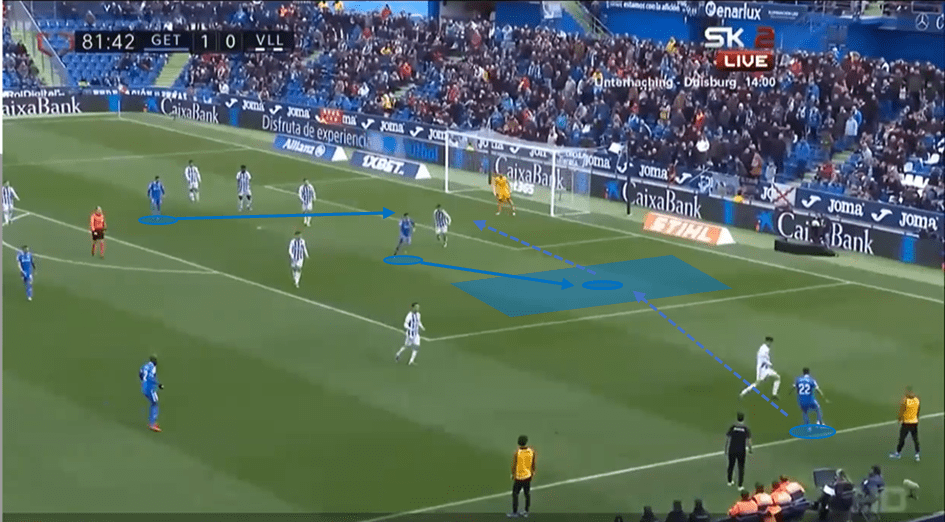
We can see his tenacity in the penalty box. He cleverly moved away from the opposition defender, who would’ve expected him to remain central and try to score the goal himself. It is the intelligent movements that he makes in the penalty box that gets him his goals. The still below shows Getafe on the attack out wide on the counter-attack. Mata is alive in the box, looking to create space for himself. He initially jinked forward, towards the crosser and then backward again, before finally holding his run, leaving himself free to touch and finish as the defenders continued their retreat. Despite being outnumbered in the box two-to-one, Mata’s clever movements lost the markers and allowed him to convert one of his four Europa League goals this season.
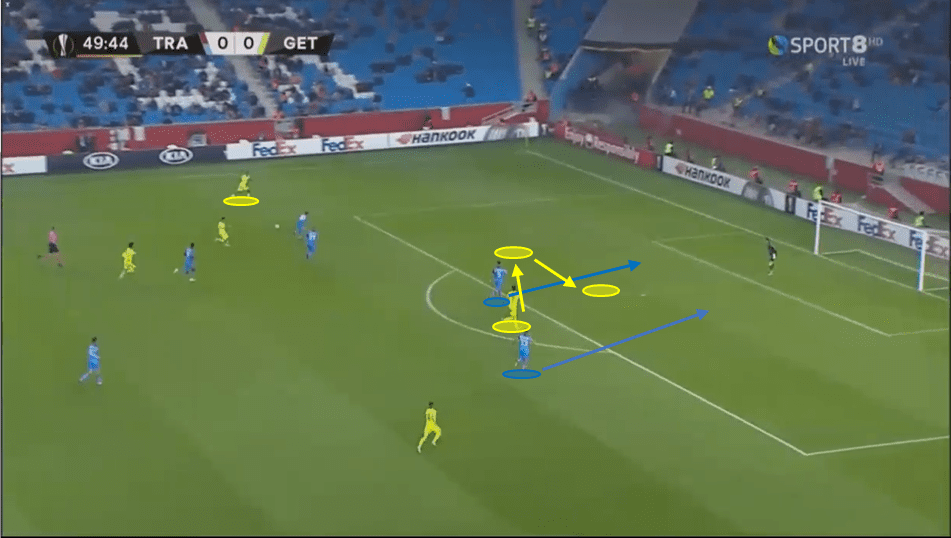
These two examples show how alive Mata is in the opposition box. His acceleration and agility benefit him here, but it is his years of attacking experience which have enabled him to score goals in the way he does. He is a true poacher, with his instincts guiding him into goalscoring positions in the box. He is uninterested in scoring in any other manner (from open play), taking just 17% of his shots from outside the penalty area.
The diagram below depicts his shot locations over the last calendar year, and we can see the concentrated geography of his shots. The size of the dot translates to the xG figure assigned to the shot. A lot of these dots are large, suggesting Mata frequently takes up positions where scoring is a probability instead of a possibility. This is simply intelligence, why give yourself a difficult shot to convert when you could have an easy one? It is no wonder his goal conversion rate from shots taken inside the box is 26%.
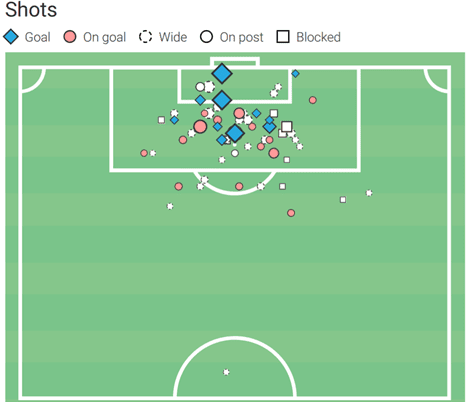
One final example of these poaching instincts can be seen in Getafe’s match away at Valencia last September. Inside the first minute, Getafe won a corner and worked it out to the edge of the box where Jason took a shot. After a clever run from the edge of the area when the corner was taken, Mata slipped away from his marker and was free at the back post. Unexpectedly, Jason scuffed his shot, pulling it way left and into the path of Mata who could tap in freely. While there is an element of luck involved in this, Mata was in an intelligent position. If Jason’s shot was on target, Mata was placed excellently for a rebound. As it turned out, the ball fell his way and he finished coolly. This goal was inside the first minute of the match too, implying Mata was alive and ready for the match, needing no time to get his eye in. It is somewhat captivating to watch a striker (at 31 years of age!) go about his business in the box with such tenacity. He truly earns his goals.
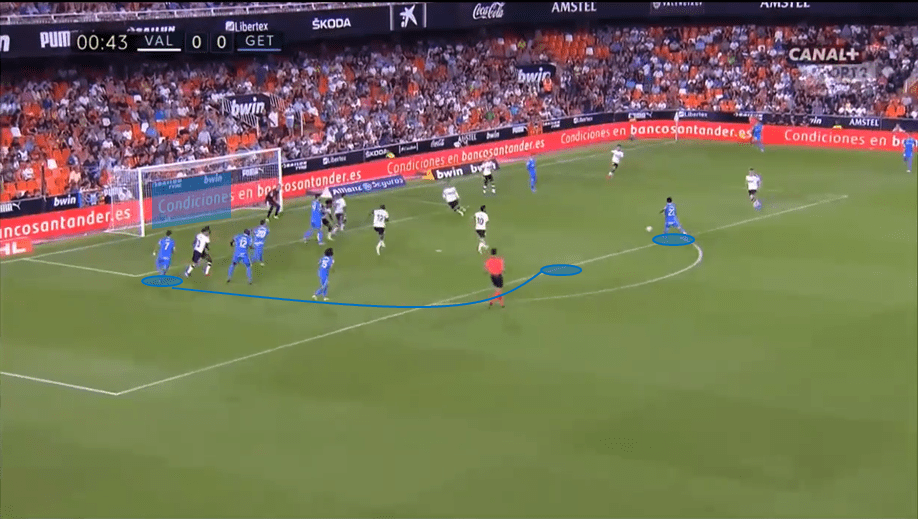
A concluding strength of Mata is his confidence from the penalty spot. The Spaniard has missed just one penalty since 2015, exemplifying his experience and confidence. The diagram below maps all of the penalties he has taken in the past five years.
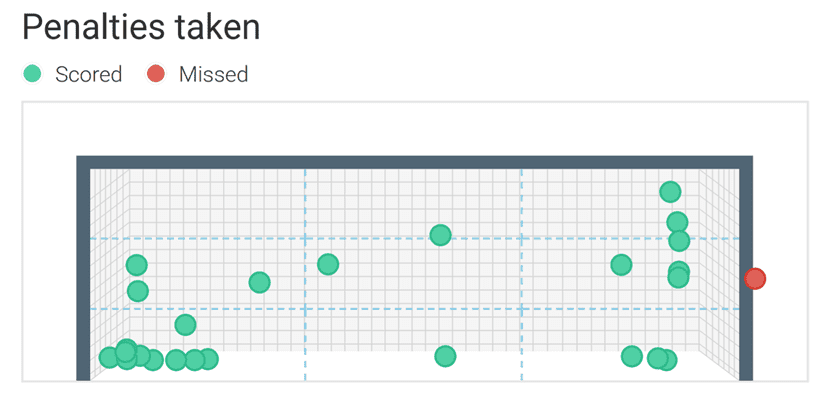
Room to improve?
At 31, it is unlikely that Mata will be able to make any significant changes or improvements to his game. Nonetheless, we will briefly address a few weaknesses in Mata’s game that sometimes hold him back. These mostly concern ball retention, something that Mata struggles with. The graphs below map Mata’s progressive passes per 90 to his passing success rate, and his progressive runs per 90 to his dribble success rate. These are plotted alongside La Liga strikers from this season.
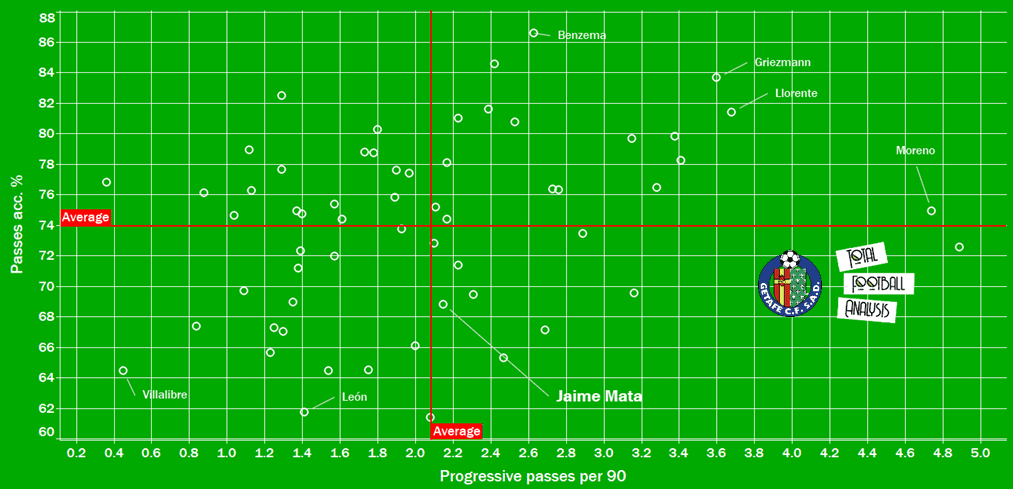
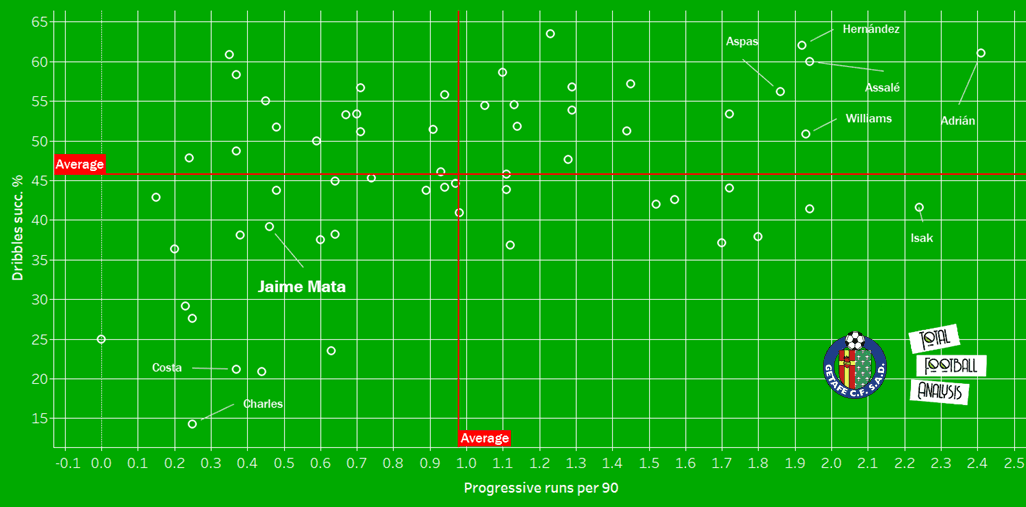
Mata attempts 2.15 progressive passes per 90, which is slightly above the average for the dataset. While this on its own isn’t hugely disappointing, one would expect Mata to attempt more, given the pace at which Getafe seek to counter-attack. Furthermore, his passing accuracy leaves much to be desired. Playing a fewer number of progressive passes per 90 is acceptable if they are frequently successful. Unfortunately, Mata’s passing accuracy is just 68.81% – way below the dataset average of 73.96%, and even further behind Karim Benzema of Real Madrid at 86.57%.
It is a similar story with his progressive runs and dribbling success rate. Mata is below average in both departments – attempting just 0.46 progressive runs per 90 and having a dribbling success rate of 39.13%. Considering the positions that Mata takes up on the counter-attack, it is surprising that he makes so few progressive runs. Also, one would believe that he’d be a more skilled dribbler than the figures suggest. If he would develop his progressive tendencies and pass and dribble with greater success, Mata would be even more of a counter-attacking threat. However, at 31, we cannot envisage such developments in Mata’s game. As a result, he is left with a frustrating losses map shown below.
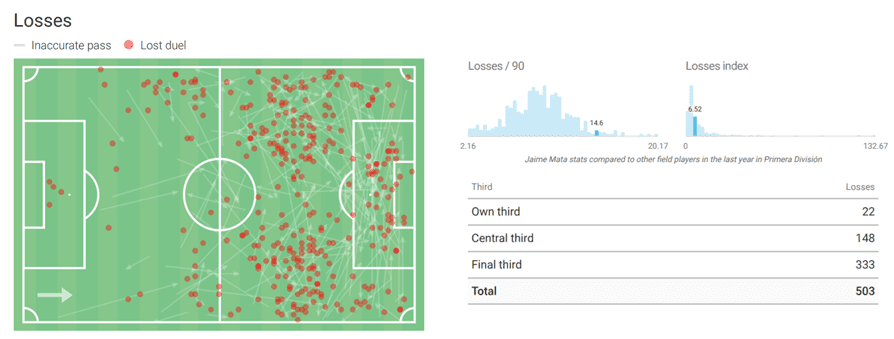
Conclusion
Jaime Mata’s play-style is dictated by the preferences of his coach, José Bordalás, and this scout report showed that he fulfils his on-pitch tasks effectively. He is willing to defend from the front and push his team high up the pitch. His pace and aerial ability allow him to be a threat on the counter-attack with high balls in-behind; upon receiving which he can create chances for his teammates. Mata is a selfless player and would prioritise a victory for his team over a goal for himself, yet his goalscoring capabilities, as displayed by this analysis, cannot be questioned. Although there are a few weaknesses to his game, at 31, he is showing no signs of slowing down and is playing the game with a charming enjoyment, respecting the work he has put in to get to where he is now.


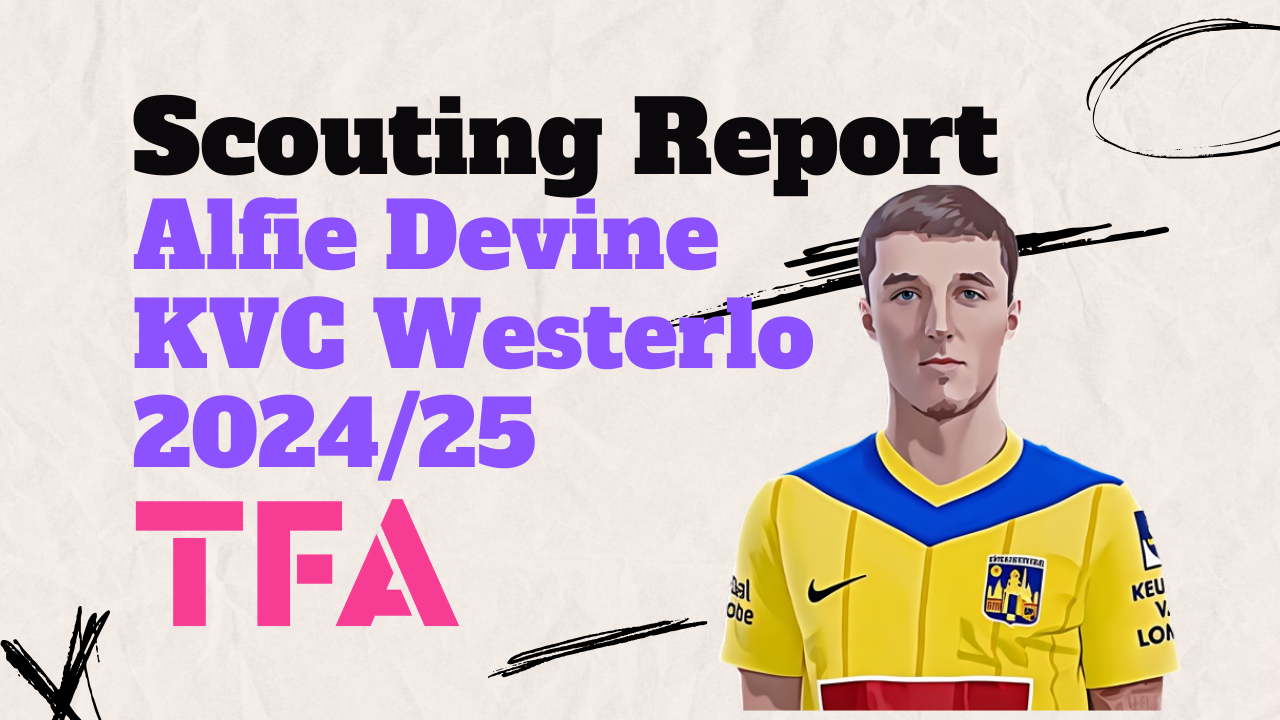
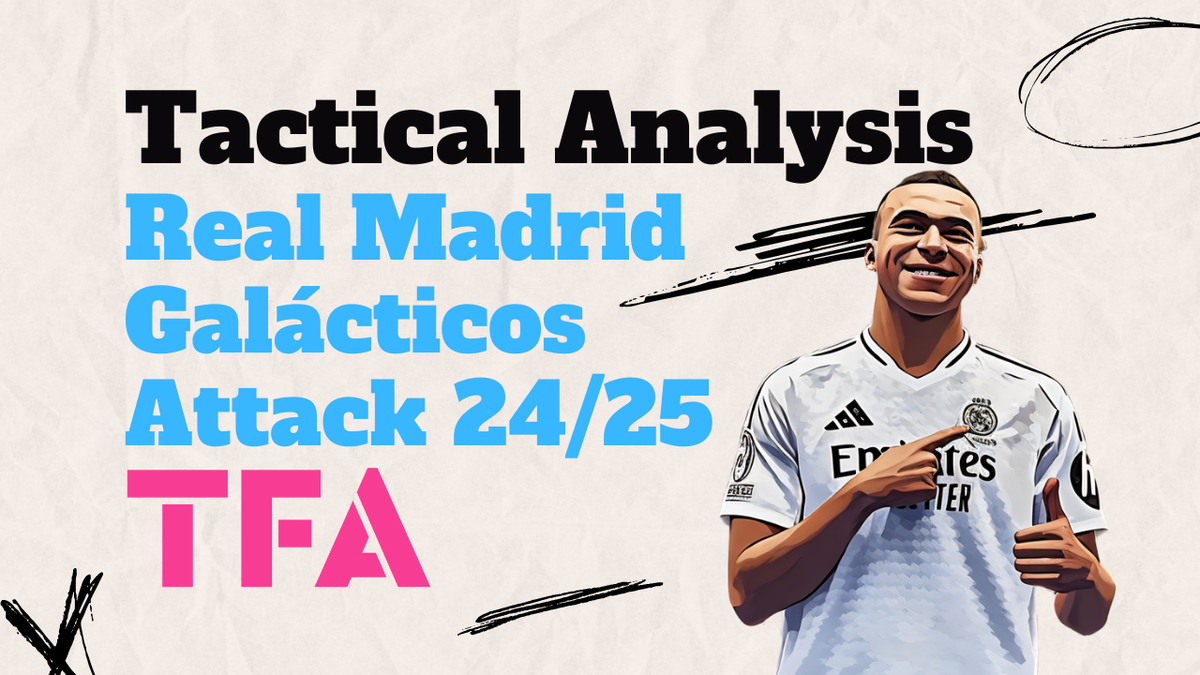
Comments